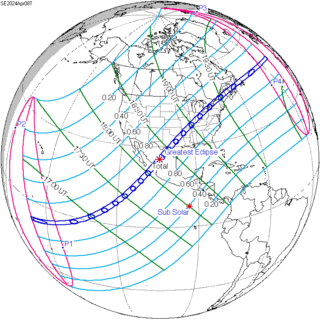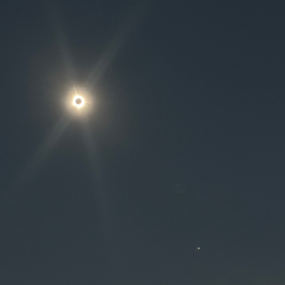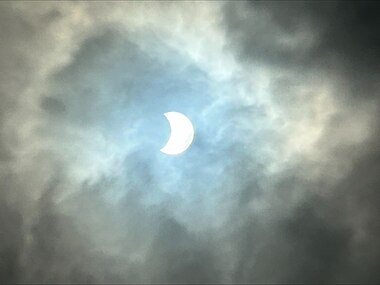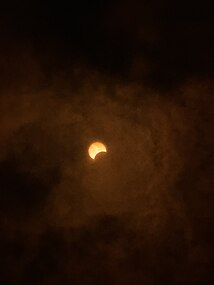Solar eclipse of April 8, 2024
| Solar eclipse of April 8, 2024 | |
|---|---|
 The solar eclipse during totality, seen from Dallas, Texas | |
| Type of eclipse | |
| Nature | Total |
| Gamma | 0.3431 |
| Magnitude | 1.0566 |
| Maximum eclipse | |
| Duration | 268 s (4 min 28 s) |
| Location | Nazas, Durango, Mexico |
| Coordinates | 25°18′N 104°06′W / 25.3°N 104.1°W |
| Max. width of band | 198 km (123 mi) |
| Times (UTC) | |
| (P1) Partial begin | 15:42:07 |
| (U1) Total begin | 16:38:44 |
| Greatest eclipse | 18:18:29 |
| (U4) Total end | 19:55:29 |
| (P4) Partial end | 20:52:14 |
| References | |
| Saros | 139 (30 of 71) |
| Catalog # (SE5000) | 9561 |
The Solar Eclipse of April 8, 2024, was a total solar eclipse visible across a band covering parts of North America, from Mexico to Canada and crossing the contiguous United States. A solar eclipse occurs when the Moon passes between Earth and the Sun, thereby obscuring the Sun. A total solar eclipse occurs when the Moon's apparent diameter is larger than the Sun's, blocking all direct sunlight. Totality occurs only in a limited path across Earth's surface, with the partial solar eclipse visible over a larger surrounding region.
The Moon's apparent diameter was 5.5% larger than average. With a magnitude of 1.0566, the eclipse's longest duration of totality was 4 minutes and 28.13 seconds just 4 mi (6 km) north of the Mexican town of Nazas, Durango.
This eclipse was the first total solar eclipse visible from Canada since February 26, 1979;[1][2] the first over Mexico since July 11, 1991;[3] and the first over the United States since August 21, 2017. No other solar eclipse in the 21st century will be totally visible from all three countries.[4] The next total solar eclipse in the US will be on March 30, 2033, which will pass over Alaska; the next total eclipse in the lower 48 states of the US will be on August 23, 2044; and the next total eclipse of similar width will take place on August 12, 2045 (traversing coast-to-coast similar to the 2017 eclipse).
The final solar eclipse of the year will occur on October 2, 2024.
Visibility in America

The totality of the solar eclipse was visible in a strip from the Pacific Ocean 230 miles (370 km) north of the Marquesas Islands and later in [ [North America]], beginning at the Pacific coast, then ascending in a northeaster ly direction through Mexico, the United States, and Canada, before ending in the Atlantic Oce an.[5]
Mexico
In Mexico, totality passed through the states of Sinaloa (including Mazatlán), Durango (including the city of Durango and Gómez Palacio), and Coahuila (including Torreón, Matamoros, Monclova, Sabinas, Ciudad Acuña, and Piedras Negras). [6][7]
A partial eclipse was visible across the remainder of the country, including 79% coverage of the solar disc in Mexico City.[8]
United States
In the United States, totality was visible through the states of Texas (including parts of San Antonio, Austin, and Fort Worth and all of Arlington, Dallas, Killeen, Temple, Texarkana, Tyler, Sulphur Springs, and Waco), Oklahoma (including Idabel and Broken Bow), Arkansas (including Morrilton/Petit Jean, Hot Springs, Searcy, Jonesboro, and Little Rock), Missouri (including Cape Girardeau and Poplar Bluff), Tennessee (extreme northwestern corner of Lake County), Illinois (including Carbondale, where it intersects the path of the 2017 eclipse), Kentucky, Indiana (including Bloomington, Evansville, Indianapolis, Anderson, Muncie, Terre Haute, and Vincennes), Ohio (including Akron, Cleveland, Dayton, Lima, Lorain, Toledo, and Warren),
Michigan (extreme southeastern corner of Monroe County), Pennsylvania (including Erie), Upstate New York (including Buffalo, Niagara Falls, Rochester, Syracuse, Watertown, the Adirondacks, Potsdam, and Plattsburgh), northern Vermont (including Burlington), New Hampshire, and Maine,[9][10] with the line of totality going almost directly over the state's highest point Mount Katahdin. The largest city that was e ntirely in the path was Dallas, Texas.[11] It was the second total eclipse visible from the central United States in just seven years, after the eclipse of August 21, 2017. It will be the last total solar eclipse visible in the contiguous United States until August 23, 2044.[12]

scheduled two special eclipse-following flights: one from Austin to Detroit on a large-window A220-300, and one from Dallas to Detroit.
[13] Various other flights in the path of totality also avoided cloud cover entirely.[14]
Canada
In Canada, totality was visible through parts of Southern Ontario (including Leamington, Fort Erie,[15] Hamilton, Niagara Falls,
Kingston, Prince Edward County, and [ [Cornwall, Ontario|Cornwall]]),[16] parts of southern Quebec (including Montreal, Sherbrooke, Saint-Georges, and Lac-Mégantic), central New Brunswick (including Fredericton, [[Woodstock, New Brunswick|Woodstock]] and Miramichi),[17] western [[Prince Edward Island]] (including Tignish and Summerside),[18][19] the northern tip of Cape Breton Island, Nova Scotia,[20] and central Newfoundland (including Gander and Grand Falls-Windsor). Then, it ended on the eastern Atlantic coast of Newfoundland.[21] Windsor, London, Toronto, and Ottawa lay just north of the path of totality, and Moncton just south of it.
A partial solar eclipse was visible in all of the other parts of Canada, except the western part of Yukon and the western tip of the Northwest Territories.
Europe
A partial eclipse passed over Svalbard (Norway), Iceland, Ireland, western parts of the United Kingdom, north-western parts of Spain and Portugal and the Azores, and the Canary Islands.[22] Cloud cover prevented views of it from most of the British Isles,[23] although it was seen in Western Scotland.[24] Unusually, this eclipse extended below the horizon, where the greatest phase was observed at mid-nautical twilight in Galicia (Spain) and the beginning of astronomical twilight in Nouvelle-Aquitaine (France).[25] The extension of the eclipse path within the twilight zone created what was likely the best observation window for the 12P/Pons–Brooks comet located closely to Jupiter.[26]
Central America and South America
The partial eclipse was seen in all Central American countries, from Belize to Panama, all the Greater Antilles (Cuba, Dominican Republic, Haiti, Puerto Rico, and Jamaica), and northern South America (Colombia).
Oceania
The partial eclipse was seen in Hawaii, eastern Kiribati (the eastern Phoenix Islands and the whole Line Islands), Tokelau, American Samoa except for its extreme western part, the Cook Islands, French Polynesia, and the Pitcairn Islands. Although all located east of the 180th meridian, the local time of the eclipse in Kiribati and Tokelau was Tuesday, April 9, 2024, because either UTC+13 or UTC+14 is observed in these areas.
Solar prominences

The eclipse occurred around the solar maximum, a period of greatest solar activity in the Sun's 11-year solar cycle, and it was predicted before the event that solar prominences could be visible during totality.[27] Several observers reported seeing solar prominences during the event.[28][29][30]
Impact
It was projected before the eclipse that there could be a $6 billion boost to the US economy due to the eclipse.[31] The Mayor of Rochester, New York, Malik Evans, told reporters that the city was expected to bring in between $10–12 million to the city's economy from the Friday before the eclipse to the day of it.[32]
One company that tracks Airbnb data likened the event to one of Taylor Swift's concerts taking place simultaneously, with visitors traveling from across the world to the path of totality in the US.[31] The prices of US motels and hotels near the path of totality increased "as much as 100 percent for the two nights in high demand".[33] Montreal saw a 20% surge in hotel occupancy for April 7th and 8th.[34] It was the first total solar eclipse visible in Montreal since 1932. The next one will be in 2205.
A restaurant in Burlington, Vermont, said that after it was reported that up to 75,000 people would be visiting the city for the eclipse reservations filled up quickly causing them to have to bring on extra staff to meet demands.[35] Other restaurants made concessions on business hours to meet the needs of the crowds.[36] In Rochester, a task force was created to help mitigate the challenges that could come about with the estimated 300,000 to 500,000 visitors that were expected to visit during the eclipse.[32] The state of Texas was projected to see up to a million visitors with cities along the path of totality cultivating festivals and other events.[37][38][39]
The eclipse was also expected[needs update] to affect solar power generation, as parts of the path of totality saw limited sunlight for over two hours. States such as Texas, California, and Florida were projected to be the most affected.[40][41]
Responses
Arkansas Governor Sarah Huckabee Sanders preemptively declared a state of emergency related to the eclipse, citing the expected increase of travel to the state which may potentially result in transportation difficulties, such as in Fort Smith, where the police prepared for traffic congestion as hotels filled up with visitors from all over the United States and Canada.[42][43] Bell County, Texas Judge David Blackburn preemptively declared a state of emergency in February 2024 due to the projected number of visitors to the area.[37] The region surrounding Niagara Falls, Ontario, also declared a state of emergency; as an existing major tourist destination along the path of totality, it expected an influx of at least one million visitors on April 8.[44]
A lawsuit was filed on April 2 by six inmates of various religions at Woodbourne Correctional Facility in New York against the state, stating that the decision to lock down the prison during the eclipse conflicted with their religious beliefs. The solar eclipse is important in various religions.[45] The state settled the lawsuit by allowing them to view the eclipse.[46]
In Ottawa, a sitting of the Public Inquiry into Foreign Interference in Federal Electoral Processes and Democratic Institutions was suspended to allow participants, staff, and journalists to view the eclipse.[47]
The Las Vegas Sphere displayed eclipse-themed visuals in celebration of the eclipse.[48]
Related eclipses
The eclipse is a member of a semester series. An eclipse in a semester series of solar eclipses repeats approximately every 177 days and 4 hours (a semester) at alternating nodes of the Moon's orbit.[49] It is also part of saros series 139, repeating every 18 years, 11 days, 8 hours, containing 71 events, and part of a tritos cycle, repeating at alternating nodes every 135 synodic months (≈ 3986.63 days, or 11 years minus 1 month).
The path of the April 8, 2024, eclipse crossed the path of the prior total solar eclipse of August 21, 2017 with the intersection of the two paths being in southern Illinois, in Makanda, just south of Carbondale.[50] The cities of Benton, Carbondale, Chester, Harrisburg, Marion, and Metropolis in Illinois; Cape Girardeau, Farmington, and Perryville in Missouri, as well as Paducah, Kentucky, were within a roughly 9,000-square-mile (23,000 km2) intersection of the paths of totality of both the 2017 and 2024 eclipses.
Gallery
Total
-
Totality with Venus as seen from Viola, Arkansas
-
Totality as seen from Russellville, Arkansas
-
Totality as seen from Hot Springs, Arkansas
-
Totality as seen from Plano, Texas, with solar prominences and chromosphere visible
-
Totality as seen from Dallas, Texas
-
Totality as seen from Austin, Texas
-
Totality as seen from Indianapolis, Indiana, with solar prominences visible
-
Diamond ring effect as seen from Ohio
-
Totality as seen from Cleveland, Ohio, behind Terminal Tower
-
Totality as seen from James N. Allan Provincial Park in Ontario
-
April 8th Total Solar Eclipse Prominences from Rondeau Provincial Park in Ontario
-
Totality as seen from Fayston, Vermont
File:April 8, 2024 solar eclipse in Dexter, southern western Ontario.jpg
Partial
-
Partial as seen from Los Angeles, California
-
Partial as seen from Santa Ana, California
-
Partial as seen from Idabel, Oklahoma
-
Partial as seen from Indianapolis, Indiana
-
Partial as seen from Washington, D.C.
-
Partial as seen from Winnipeg, Manitoba
-
Partial as seen from Southeastern Pennsylvania
-
Partial as seen from Philadelphia, Pennsylvania
-
Partial as seen from Evesham Township, New Jersey
-
Partial as seen from Marquette, Michigan
-
Partial as seen from Plainfield, New Jersey
-
Partial as seen from Little Mountain, South Carolina
-
Partial as seen from Matamoros, Tamaulipas
-
Partial as seen from San Nicolás de los Garza, Nuevo León
-
Partial as seen from Viola, Arkansas
-
Partial as seen from Salem, Oregon
-
Partial as seen from New Orleans, Louisiana
File:April 8, 2024 solar eclipse in Dexter, southern western Ontario.jpg
Pinholes
-
Natural pinholes as seen from College Station, Texas
-
Natural pinholes as seen from Georgia
-
Pinhole made via cardboard box in Dallas, Texas

See also
References
- ^ Aziz, Saba (February 12, 2024). "Total solar eclipse: All you need to know about the rare celestial event". Global News. Archived from the original on February 13, 2024. Retrieved February 13, 2024.
- ^ Dickinson, Terence (August 3, 2017). "Canada's last solar eclipse in 1979". Maclean's. Archived from the original on August 12, 2017. Retrieved August 24, 2017.
- ^ Total Solar Eclipse in Mexico, 1991 (in Spanish). National Autonomous University of Mexico. 1991. ISBN 9789683617613. Archived from the original on February 15, 2023. Retrieved April 2, 2009.
- ^ "Location of Total Solar Eclipse of April 8, 2024", GreatAmericanEclipse.com, archived from the original on August 26, 2017, retrieved September 9, 2017
- ^ cience.nasa.gov/eclipses/future-eclipses/eclipse-2024/where-when/ Where & When, NASA, April 6, 2024, retrieved April 8, 2024
{{citation}}:|archive-date=requires|archive-url=(help); Check|url=value (help); Unknown parameter|archive-u rl=ignored (help)CS1 maint: url-status (link) - ^ olar-eclipse-april-8-2024 "Total Solar Eclipse in Mexico". Space news. April 2024. Retrieved April 7, 2024.
Mazatlán, on the country's western coast, will be the first region of mainland Mexico to experience t otality, followed by Durango, Torreón, and Monclova as the path tracks northeast toward the U .S. border at Piedras Negras.
{{cite web}}:|archive-date=requires|archive-url=(help); Check|url=value (help); Unknown parameter|archive- url=ignored (help); Unknown parameter|archive-ur l=ignored (help); line feed character in|quote=at position 14 (help)CS1 maint: url-status (link) - ^ "Solar Eclipse of April 8 2024 from Mazatlán, Mexico". The Sky Live. April 7,
2024. Retrieved April 7, 2024.
A Total Eclipse of magnitude 1.0216 will be visible from M azatlán, Mexico on April 8 2024. Maximum eclipse will be at 11:09:38 local time and totality duration will be 4m 19s.
{{cite web}}:|archive-date=requires|archive-url=(help); Check date values in:|date=(help); Unknown parameter|archive-u rl=ignored (help); line feed character in|date=at position 10 (help); line feed character in|quote=at position 153 (help)CS1 maint: url-status (link) - ^ "Gran Eclipse Mexicano 2024". Instituto de Geofísica, UNAM. Archived from the original on April 8, 2024. Retrieved 8
April 2024.
{{cite web}}: Check date values in:|access-date=(help); Unknown parameter|url-st atus=ignored (help); line feed character in|access-date=at position 3 (help) - ^ Gore, Leada (August 22, 2017). "Solar eclipse 2024: Best U.S. cities to see the next total solar eclipse". The Birmingham News.
{{cite news}}:|archive-date=requires|archive-url=(help); Unknown parameter|access-d ate=ignored (help); Unknown parameter|archive- url=ignored (help)CS1 maint: url-status (link) - ^ Eliasen, Terry (August 21, 2017). new-england-totality/ "Next Solar Eclipse Puts New England in Path Of T otality". CBS Boston. Retrieved February 11, 2018.
{{cite news}}:|archive-date=requires|archive-url=(help); Check|url=value (help); Unknown parameter|archive- url=ignored (help)CS1 maint: url-status (link) - ^ "Great North American Eclipse: Dallas". Perot Museum of Nature and Science. April 3, 2024. Retrieved April 7, 2024.
On April 8, 20 24, Dallas will be the largest city in the path of totality for the once-in-a-lifetime Great North American Eclipse.
{{cite web}}:|archive-date=requires|archive-url=(help); Unknown parameter|archive-u rl=ignored (help); line feed character in|quote=at position 109 (help); line feed character in|title=at position 13 (help)CS1 maint: url-status (link) - ^ { {citation |last1=Hauari |first1=Gabe |title=When is the next total solar eclipse in the US a fter 2024? Here's what you need to know. |date=2024-03-01 |url=https://www.usatoday.com/story/news/nation/2024/03/01/when-is-next-total-solar-eclipse-u s-2044-path-totality/72757679007/ |access-date=2024-04-08 |language=en-US |last2=Lagatta | first2=Eric |work=USA Today |archive-date=April 8, 2024 |archive- url=https://web.archive.org/web/20240408002306/https://www.usatoday.com/story/news/nation/2024/ 03/01/when-is-next-total-solar-eclipse-us-2044-path-totality/72757679007/ |url-status=live }}
- ^ Lamothe, Jacqueline (April 8, 2024). eclipse-2-spectacular-flights-how-delta-people-are-preparing-celestial-event "1 solar eclipse, 2 spectacular flights: H ow Delta people are preparing for the celestial event". Delta News Hub. Retrieved April 8, 2024.
{{cite news}}:|archive-date=requires|archive-url=(help); Check|url=value (help); Unknown parameter|archive-u rl=ignored (help); line feed character in|website=at position 12 (help)CS1 maint: url-status (link) - ^ Template:Cite ne ws
- ^ Jubier (April 7, 2024). t=42.90178&Lng=-78.97217&Elv=189.0&Zoom=8&LC=1 "Total Eclipse for Fort Erie, Canada". Google Maps.
Fort Erie totality 3m 46s.
{{cite web}}:|archive-date=requires|archive-url=(help); Check|url=value (help); Unknown parameter|access-dat e=ignored (help); Unknown parameter|archive- url=ignored (help); Unknown parameter|firs t=ignored (help); Unknown parameter|url- status=ignored (help) - ^ Nielsen, Kevin (April 5, 2024). "Total solar eclipse: Where the best views in Ontario are expected to be". Global News. clipse-viewing-locations/ Archived from the original on April 7, 2024. Retrieved April 7, 2024.
Fort Erie will experience the longest totality at 3m 46s, with Niagara Falls following c losely at 3m 31s, both occurring at 3:20 pm.
{{cite news}}: Check|archive-url=value (help) - ^ "N.B. has front-row seat for 'once-in-a- lifetime' total solar eclipse on April 8". CBC News. January 22, 2024. Retrieved April 7, 2024.
Fredericton, Woodstock, and Miramichi are in the 'path of totality'. Moncton and Saint John, just outside, had about 98% sun coverage.
{{cite news}}:|first=missing|last=(help); Unknown parameter|archive- url=ignored (help); Unknown parameter|archive-da te=ignored (help); Unknown parameter|l ast=ignored (help); line feed character in|quote=at position 88 (help)CS1 maint: url-status (link) - ^ Goodsell, Devon (September 5, 2022). CBC News 1.6559596 https://www.cbc.ca/news/canada/prince-edward-island/pei-total-eclipse-2024- 1.6559596. Retrieved April 7, 2024.
Totality visible west of Summerside: 1m 2s. In Tignish, totality lasts 3m 12s.
{{cite news}}:|archive-date=requires|archive-url=(help); Check|url=value (help); Missing or empty|title=(help); Unknown parameter|archive-ur l=ignored (help); Unknown parameter|ti tle=ignored (help); line feed character in|quote=at position 48 (help)CS1 maint: url-status (link) - ^ "Timing of 2024 Solar Eclipse". University of Prince Edward Island. March
28, 2023. Archived from the original on April 7, 2024. Retrieved April 7, 20
24.
Timing and duration of the total eclipse will vary slightly across the Island.
{{cite web}}: Check date values in:|access-date=and|date=(help); line feed character in|access-date=at position 13 (help); line feed character in|date=at position 7 (help) - ^ "NASA – Total Solar Eclipse of 2024 Apr 08". March 27, 2008. Archived from the original on March 27, 2008.
- ^ Jubier, Xavier (April 7, 2024). "The Eclipse vanishing off the eastern coast of Newfoundland, Canada". Google Maps. Archived from the original on April 8, 2024. Retrieved April 7, 2024.
Totality on the eastern coast of Newfoundland: 2m 53s.
- ^ "Eclipse Path of Total Solar Eclipse on April 8, 2024". www.timeanddate.com. Archived from the original on March 13, 2020. Retrieved April 10, 2020.
- ^ McDonagh, Darragh (April 8, 2024). "Cloud spoils solar eclipse for Irish stargazers". Daily Mirror. Retrieved April 9, 2024.
- ^ "Eclipse 2024: Partial eclipse seen in Scotland as most of UK misses out". April 8, 2024 – via www.bbc.co.uk.
- ^ "2024 solar eclipse in Europe". European Eclipse Quadruplet. Archived from the original on November 3, 2023. Retrieved November 3, 2023.
- ^ "12P/Pons Brooks comet during 2024 total solar eclipse". Astro-Geo-GIS.com. April 14, 2023. Archived from the original on October 26, 2023. Retrieved October 26, 2023.
- ^ Carter, Jamie (March 23, 2023). "Massive explosions may be visible on the sun during the April 8 total solar eclipse". Space.com. Archived from the original on April 8, 2024. Retrieved April 8, 2024.
- ^ Bartels, Meghan (April 8, 2024). "What Were the Red Dots around the Total Solar Eclipse?". Scientific American. Archived from the original on April 9, 2024. Retrieved April 8, 2024.
- ^ Robledo, Anthony; Lagatta, Eric (April 8, 2024). "Solar flares reported during total eclipse as sun nears solar maximum. What are they?". USA Today. Archived from the original on April 9, 2024.
- ^ Bassler, Hunter; Allred, Anne (April 8, 2024). "Possible massive sun explosion captured on camera by Chicago eclipse viewer in Cape Girardeau". KSDK. Archived from the original on April 9, 2024. Retrieved April 8, 2024.
- ^ a b Hyatt, Diccon (April 6, 2024). "What's the Economic Impact of the Solar Eclipse?". Investopedia. Archived from the original on April 8, 2024. Retrieved April 8, 2024.
- ^ a b Kekatos, Mary (April 5, 2024). "How Rochester, New York, hopes the eclipse brings a lasting economic boom to city". ABC News. Archived from the original on April 8, 2024. Retrieved April 8, 2024.
- ^ "Total Solar Eclipse Causes Surge in Pricing and Demand for Hotels, Airbnbs: What to Know as a Traveler". Peoplemag. April 5, 2024. Archived from the original on April 8, 2024. Retrieved April 8, 2024.
- ^ Rassy, Swidda (April 8, 2024). "Tourism up in Montreal due to total solar eclipse".
- ^ Boronski, Tyler (April 6, 2024). "Burlington restaurants starting to feel the impact of the Eclipse weekend". WPTZ. Retrieved April 9, 2024.
- ^ Boronski, Tyler (April 6, 2024). "Burlington restaurants starting to feel the impact of the Eclipse weekend". WPTZ. Archived from the original on April 6, 2024. Retrieved April 8, 2024.
- ^ a b Flores, Bri; Audacy • •, Chris Blake | (April 7, 2024). "How will eclipse-driven tourism impact the Texas economy?". NBC 5 Dallas-Fort Worth. Archived from the original on April 7, 2024. Retrieved April 8, 2024.
- ^ "Atlas Obscura Announces the 2024 Ecliptic Festival Celebrating the Total Solar Eclipse". www.businesswire.com. January 16, 2024. Archived from the original on February 28, 2024. Retrieved April 8, 2024.
- ^ Edmonds, Colbi (April 8, 2024). "In Austin, thousands watched the eclipse during a Vampire Weekend concert". New York Times. Archived from the original on April 9, 2024. Retrieved April 8, 2024.
- ^ Johnson, Marina (April 8, 2024). "How does the 2024 solar eclipse affect solar power? Here's what to know". The Indianapolis Star. Archived from the original on April 9, 2024. Retrieved April 8, 2024.
- ^ "Eclipse Will Darken Solar Panels and Cut Off Power Supplies to the Grid". Bloomberg.com. April 8, 2024. Archived from the original on April 8, 2024. Retrieved April 8, 2024.
- ^ Rains, Brett (April 4, 2024). "Fort Smith police prepare for traffic congestion as hotels fill up for the eclipse". KHBS. Archived from the original on April 6, 2024. Retrieved April 8, 2024.
- ^ Sosa, Abner (April 6, 2024). "Gov. Sarah Huckabee Sanders declares state of emergency ahead of solar eclipse". KHBS. Archived from the original on April 7, 2024. Retrieved April 7, 2024.
- ^ Li, Justin (March 30, 2024). "Niagara Falls declares state of emergency in advance of huge influx of eclipse visitors". CBC News. Archived from the original on April 7, 2024. Retrieved April 8, 2024.
- ^ Lagetta, Eric (April 2, 2024). "New York inmates say a prison lockdown for the eclipse violates their religious freedoms: Lawsuit". USA Today. Archived from the original on April 8, 2024. Retrieved April 8, 2024.
- ^ Helsel, Phil; McLaughlin, Evan (April 4, 2024). "Inmates at New York prison will get to watch eclipse after all". NBC News. Archived from the original on April 8, 2024. Retrieved April 8, 2024.
- ^ Schmunk, Rhianna (April 8, 2024). "Total solar eclipse sends parts of Canada into darkness". CBC News. Retrieved April 9, 2024.
- ^ "Las Vegas Sphere Pays Homage to Solar Eclipse". Yahoo News. April 9, 2024. Retrieved April 9, 2024.
- ^ van Gent, R.H. "Solar- and Lunar-Eclipse Predictions from Antiquity to the Present". A Catalogue of Eclipse Cycles. Utrecht University. Archived from the original on September 7, 2019. Retrieved October 6, 2018.
- ^ "Total Solar Eclipse 2017 – Path Overlap with the 2024 Eclipse". eclipse2017.org. Archived from the original on September 3, 2017. Retrieved September 1, 2017.
External links
- 2024 Total Solar Eclipse – CNN
- Average cloud coverage during total eclipse of 2024-04-08: Canada US Mexico
- Besselian Elements for the Total Solar Eclipse of 2024 Apr 08
- Hermit Eclipse: Total Solar Eclipse April 8, 2024
- Illustrated, nontechnical talk by astronomer Andrew Fraknoi about this eclipse and safe viewing
- Eclipse Simulator from Eclipse2024.org
- All 50 state maps showing animation for various cities in each state in the US
- Live broadcast of the eclipse at NASA website
- Live broadcast of the eclipse at Virtual Telescope Project website




































